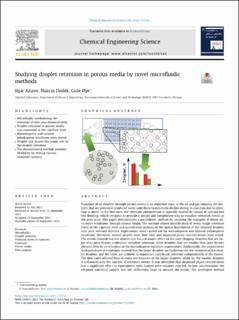| dc.contributor.author | Azizov, Ilgar | |
| dc.contributor.author | Dudek, Marcin | |
| dc.contributor.author | Øye, Gisle | |
| dc.date.accessioned | 2023-02-16T12:16:54Z | |
| dc.date.available | 2023-02-16T12:16:54Z | |
| dc.date.created | 2021-10-08T18:09:24Z | |
| dc.date.issued | 2022 | |
| dc.identifier.citation | Chemical Engineering Science (CES). 2022, 248 . | en_US |
| dc.identifier.issn | 0009-2509 | |
| dc.identifier.uri | https://hdl.handle.net/11250/3051487 | |
| dc.description.abstract | Transport of oil droplets through porous media is an important topic in the oil and gas industry. Oil droplets that are present in produced water contribute to injectivity decline during re-injection due to retention in pores. In the literature, the retention phenomenon is typically studied by means of core/packed bed flooding, which struggles to provide a simple and inexpensive way to visualize retention events at the pore scale. This paper demonstrates a microfluidic method for studying the transport of dilute oil-in-water emulsions through porous media. The method allows identification of every single retention event at the capillary level and quantitative analysis of the spatial distribution of the retained droplets over pore volumes injected. Experiments were carried out for monodisperse and tailored polydisperse emulsions. Moreover, several droplet sizes, flow rates and dispersed phase concentrations were tested. The results showed that the droplet size has a dramatic effect on the pore clogging. Droplets that are larger than pore throats underwent complete retention, while droplets that are smaller than pore throats showed little to no retention in the monodisperse emulsion experiments. Additionally, the experiments with polydisperse emulsions showed that the larger droplets are facilitators for the retention of the smaller droplets, and the latter are unlikely to experience significant retention independently of the former. The flow rates affected flow re-entry mechanisms of the larger droplets, while for the smaller droplets it influenced only the number of retention events. It was identified that dispersed phase concentration has a significant effect in experiments with limited pore volumes injected. At low concentration, the obtained statistical sample was not sufficiently large to unravel the trends. The developed method presents a solid foundation for further experiments and developments in microfluidic studies of the emulsion transport. | en_US |
| dc.language.iso | eng | en_US |
| dc.publisher | Elsevier Ltd. | en_US |
| dc.rights | Navngivelse 4.0 Internasjonal | * |
| dc.rights.uri | http://creativecommons.org/licenses/by/4.0/deed.no | * |
| dc.title | Studying droplet retention in porous media by novel microfluidic methods | en_US |
| dc.title.alternative | Studying droplet retention in porous media by novel microfluidic methods | en_US |
| dc.type | Peer reviewed | en_US |
| dc.type | Journal article | en_US |
| dc.description.version | publishedVersion | en_US |
| dc.source.volume | 248 | en_US |
| dc.source.journal | Chemical Engineering Science (CES) | en_US |
| dc.identifier.doi | 10.1016/j.ces.2021.117152 | |
| dc.identifier.cristin | 1944532 | |
| dc.relation.project | Norges forskningsråd: 237893 | en_US |
| cristin.ispublished | true | |
| cristin.fulltext | original | |
| cristin.qualitycode | 2 | |

